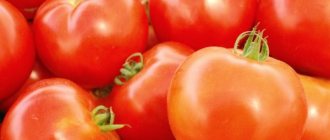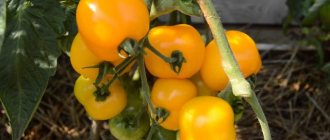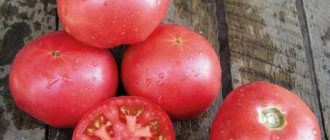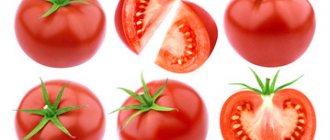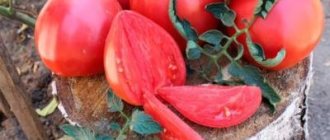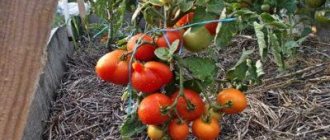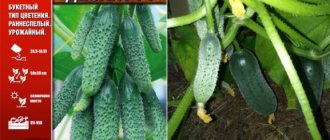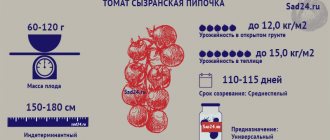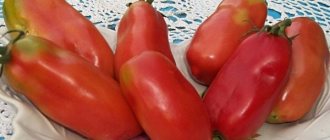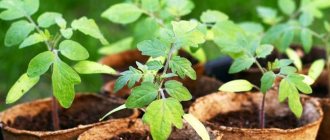Tomato Niagara: features of the variety
As mentioned earlier, by its appearance, we are talking not only about the shape of the vegetable itself, but also about the order of arrangement on the bush; the variety is significantly different from those varieties of tomatoes that, as a rule, grow in the beds of ordinary gardeners. Popularly, the elongated shape of the Niagara tomato is called “cream”. This is a little different from the “cream” that can be found in the fall in almost all markets of the country, but nevertheless the variety is gradually gaining its popularity. And then, in terms of the density of the pulp, tomatoes of the above variety definitely deserve a positive rating. After processing, you get an excellent tomato paste or fruit drink.
Now let's talk about the bush itself. Experts advise growing Niagara tomatoes in greenhouses. But, as practice shows, enthusiastic gardeners tried to grow this relatively new variety in the open ground. Yield indicators are more than decent. Therefore, if there is a desire to experiment a little and diversify the usual varieties and hybrids of tomatoes with new options, then we can safely recommend “Niagara”. An excellent result, regardless of what kind of weather the summer will “pamper”, is guaranteed.
Vegetable information
The Niagara tomato variety has medium-early fruit ripening. From the moment the first shoots appear until the fruits form, approximately 108 days pass.
The variety is not a hybrid, but is resistant to cold and heat. Since the seedlings tolerate cool weather, they can be planted as early as the 20th of March. The reviews also note the yield of Niagara tomatoes. From each tomato bush you can remove up to 10 kg of tomatoes.
The characteristics of a tomato bush allow you to get a better idea of growing and caring for it. Tomatoes belong to the indeterminate group of plants. The stem has unlimited growth of the central stem. In a heated greenhouse, the bush can grow for more than a year, forming up to 45 crop clusters.
Can be grown both in open ground and in a greenhouse. An important condition is to install the support for tying in a vertical or horizontal position.
The bush is medium leafy. Each leaf is small in size and rich green in color. Despite the fact that the plant can reach a height of up to 180 cm, the bush is compact and the plantings take up little space. The root system is powerful.
To increase yield, it is best to form three stems. But you can leave one central trunk. In this case, it will be stronger and more stable, and the fruits will form much larger.
The variety tolerates diseases well and is rarely attacked by pests. It does not succumb to blossom end rot and very rarely suffers from a fungal infection such as late blight.
Seeds can be planted as seedlings or directly in open ground. During this period, minimal fertilizing is required; a mixture of compost and soil is suitable. Seedlings of the Niagara variety are planted in holes at a distance of approximately 25 cm. Since the stem stretches high, tying is recommended. During the growing season, more frequent application of organic or mineral fertilizers is necessary.
See also
Characteristics and description of the Irishka tomato variety, its yieldRead
What to look for when growing tomatoes
All those who have at least once in their life been involved in growing tomatoes on their plot know very well that achieving a positive result largely depends on the correct planting of seeds. The rule is valid both for greenhouse cultivation and for ordinary cultivation in open ground. Niagara seeds, according to reviews from gardeners who have personally grown them, do not germinate particularly well. As a rule, half of the total number of seeds planted germinates. That is why planting density plays a role.
Have the seeds sprouted? Fine. Now future seedlings need to be provided with sufficient lighting - at least 16 hours under a special “phyto-lamp”. Buying a fluorescent lamp for greenhouses is now relatively simple. In any specialized store, sources of gentle artificial light are offered in a wide range. We are talking about both the shape and the power of the lamp. The price remains at an affordable level.
After the future “tomato” bushes are strong enough, they can be planted in the garden under the open sky. Special care is no longer required here. If desired, given that from one bush you can collect from 8 to 10 kilograms of “extended cream”, you can “feed” the plant with the usual organic fertilizers.
An important point: vegetables stick very poorly to the bush. Yes, falling does not mean rapid spoilage, and the tomatoes lay very well, but both watering and harvesting require caution and attention.
Features of planting and care
There are several useful recommendations for proper planting of Niagara tomatoes and further care that will help increase the percentage of germination and ensure maximum yield.
Planting Niagara tomatoes should be done in the following sequence:
- At the beginning of March, it is good to warm the soil in the greenhouse and fertilize it with complex mixtures.
- Make holes 1 cm deep, keeping a distance of 4-5 cm between planting units.
- Place the seeds into moist soil. Usually about 20-25% of seeds germinate.
- After 2-3 true leaves appear, you can begin picking and replanting in open ground.
- Choose a well-lit, draft-free place.
- Add inorganic fertilizers to the soil in advance and, having dug small holes at a distance of 20-25 cm, plant the seedlings in open ground.
- Provide all conditions for further growth of seedlings.
In order for the Niagara tomato variety to meet all expectations and present a rich harvest, you must follow all the rules for caring for the plant:
- After planting, it is necessary to carefully monitor the growth of the plant and regularly check it for the presence of characteristic symptoms of diseases and pests.
- Carry out at least three feedings: the first - after a week after planting, the second - when the plant begins to bloom, and the third - during the fruiting period.
- It is better to use phosphorus and potassium mixtures as fertilizers.
- Trim the plant regularly, leaving only 2 stems. If there are more of them, the plant will spend a lot of nutrients on their maintenance, and not on the development of fruits. Therefore, to obtain large tomatoes, it is better to leave only one stem after forming pruning.
- Regularly tie up the plant, since heavy stress on fragile stems due to massive fruits can negatively affect garden crops. A lot of energy will be spent not on shaping the tomatoes, but on strengthening the branches, which, in the absence of additional resources, may break off.
- If after pruning there is only one trunk left, then the plant does not need to be fixed to a support, since it will be strong enough to support the mass of fruits.
- Watering should be carried out no more than 1-2 times a week, using warm water. Apply the liquid under each bush directly to the surface of the root system.
- After watering, loosen the soil and remove all weeds. In rainy weather, avoid this procedure, as excess moisture can provoke the development of late blight on garden crops.
Details about the correct formation of tall tomato varieties:
You should not allow the tomatoes to turn a deep red color or overripe them. This may slow down the growth of the remaining tomatoes.
Buy tomato seeds
A visit to our website will help resolve this issue. The thing is that, through a specialized resource, every interested gardener, regardless of the level of professionalism, can not only purchase plant seeds that have been repeatedly tested in real conditions, but also receive full-fledged advice.
For example, on the pages of the above source, not only Niagara tomato photos , but also reviews, as well as conditions for purchasing seeds. Prices are distinguished by their democratic nature. It is important to note the site’s interface, which is intuitive.
If the question regarding the purchase of tomato seeds or other vegetables is extremely pressing and there is a desire not only to buy profitably, but also to receive professional advice, visiting the website of Ilya Korolev’s Royal Garden will be a good solution.
Description of fruits
In relation to Niagara, any compromise that we have already discussed can be called a golden mean. When we talk about tomatoes, we mean large-fruited giants and cherry cherries.
Size
Niagara is a plum-shaped variety with an average weight of one-dimensional fruits of 60-80 g. The fruits really look like very large plums with a sharp nose. The ratio of the length of tomatoes to their width is 3:1.
Such cream, even of the largest size, fits into the neck of the jar and is thus suitable for whole-fruit canning.
Their thick, bright red skin ensures long-term storage of the harvested crop and is not prone to cracking during heat treatment. In general, Niagara is a universal purpose variety.
The good taste of the fruits makes them attractive for fresh use, including in salads. This tomato is also well suited for making juices, pastes and ketchups.
Characteristics of the variety
Mid-early productive variety. Ripening begins after 3 months, approximately 108-110 days after the first leaves appear. The non-hybrid species is resistant to both cold and heat. When grown in a heated greenhouse, a tomato can grow throughout the year and form up to 45 fruit clusters.
The Niagara tomato variety is characterized by the commercial appearance of the fruit. To speed up the development of the ovary, the tops of the tomato trunk are pinched in mid-August. Flowers are formed through a node. There are no barren flowers. To get a larger harvest, only 8 flowers are left in the brush.
Ripening is not simultaneous, which allows you to collect fruits all summer. The more stems are formed, the smaller the fruit size will be.
Description of fruits
Tomatoes are classified as plum tomatoes. They have an elongated shape and a small pointed “nose”. The fruit has a rather dense, but not hard peel that does not burst during heat treatment. According to the characteristics, the pulp is juicy, with a pronounced characteristic taste.
Unripe fruits are light green in color. As they ripen, the tomatoes turn bright red.
Description of the bush
The tomato bush is compact, indeterminate, up to 1.8 m high, medium-leafed, and has a powerful root system. The leaves are medium sized, rich green in color. According to the description, 8-14 fruits are tied on the brush.
The stems are thin, but this does not affect fruiting. Formation is carried out up to 3 stems. Due to the fact that the bush of the crop is not spreading, up to 4 plants are planted per 1 m².
Productivity
According to the characteristics of the variety, Niagara tomatoes have high yields. Proper care allows you to get about a bucket of fruits from one crop. The productivity of the plant is not affected by changes in weather conditions.
The first harvest is harvested in July. Peak fruiting occurs in mid-August.
Advantages and disadvantages
According to the description, tomato has the following benefits:
- resistance to various nightshade diseases (cases of late blight are rare);
- stable and high yield;
- good keeping quality;
- grows well in both warm and cool weather;
- easily tolerates both drought and dampness.
The variety also has disadvantages:
- seeds do not germinate well - to minimize the problem it is necessary to use growth stimulants and hydrogen peroxide;
- thin stems require constant support;
- ripe fruits on the clusters may fall off when touched.
Resistance to diseases and pests
According to the characteristics of the variety, many diseases and pests that often affect nightshade crops are not harmful to the Niagara tomato. Late blight can only occur in very rainy summers; blossom end rot has not been noticed during the entire period of growing tomatoes.
Proper care will keep the plant healthy
The plant can be attacked by some insects. The most important enemy of culture is the Colorado potato beetle. For prevention, the root zone is covered with sawdust or pesticides are used.
If you plant the crop correctly and care for it, it will not be subject to diseases and pest invasions. The plant is suitable for those people who want to have a large harvest without spending a lot of time on preventative measures.
Area of application of fruits
The fruits are an excellent raw material for preparing an unusual delicacy - sun-dried tomatoes. You can also make thick and tasty juice from them. Tomatoes are suitable for making pasta, ketchup, as well as for canning, pickling and pickling.
But many housewives use tomatoes in cosmetology. They are used to create nourishing masks for skin toning. Such procedures help make it elastic and improve complexion.
